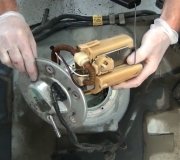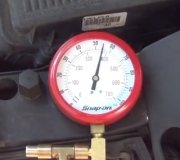Joe, thank you also for the instructions on testing the ECU. I'd like to check the other components that go out more frequently before I have to try getting to the ECU, since that's less likely to be the problem than several of the other components.
Here is more information on my problems starting my 1990 760T. I have just completed an extensive tune-up on many of the basic components of the car. When completed, I still had a very rough idle, which I eventually discovered was a vacuum leak in the intake manifold. I installed a new intake manifold gasket and got the car running smoothly. But a few weeks after completing that job, I went out to start the car one morning and got no cranking or starting. I did some step-by-step troubleshooting and concluded the starter itself was bad. I bought a new one at the parts store and installed it (while lying on the ground under the car -- a tight fit and an awkward job), and the car started up perfectly, but this time it ran very rough again, with symptoms of another vacuum leak. After looking all through the engine for the vacuum leak, I discovered that the cover to the air manifold was on crooked and when I put it on correctly, the engine started easily and ran smoothly for about 10 seconds before stalling.
This is the situation I'm currently in: I can repeatedly start the engine easily, but it appears to lose fuel after about 10 seconds. If I give it more throttle, it speeds up for a couple of seconds but then stalls after all. The tachometer doesn't drop to zero before stalling, so it doesn't appear to be losing electrical power. I have tested the OBD type 1 diagnostics but get 1-1-1, meaning no faults detected. The service light is on when I get the car running. When I turn the key to ignition but not to start, I don't hear any fuel pump noise from either the in-tank primer fuel pump or the in-line main fuel pump -- I think both should be running for about 1.5 seconds to prime the fuel system. I don't understand how I can keep starting the car easily if the fuel pumps are not operating at all.
So I want to test the relays that could be causing the fuel to cut out. 1) The fuel pump relay, where I could jump the terminals to bypass the relay and see if the fuel pumps are operating if I could get the relay out of its socket. 2) The radio interference relay (antenna relay) is also often the cause of similar problems. I haven't even found where that's located on my car. 3) The rpm relay is mounted on the flywheel (in my car this has replaced the Hall sensor that was mounted on the distributor cap in earlier model years), and I will see whether I can jump that one while starting. 4) This is a coolant temperature sensor that could be causing the fuel to cut off after it runs for a while. 5) There is a throttle switch that adjusts spark and fuel after the engine starts. 6) There is an ignition module that has caused starting issue from some car owners. 7) There is a fuel accumulator (pressurized reservoir for the constant flow fuel system) that could be causing problems if clogged. 8) The air mass meter could be the problem, but I don't think these symptoms sound like it's the culprit. The main problem is that I'm not sure how to test these various relays, sensors and other parts, so I want to test the parts that most commonly cause this kind of crank but no-start symptoms.
I have tried to remove the main fuel pump to run jumpers directly from the battery to see if it is working (very briefly so I don't ruin the vanes), but I can't for the life of me get the electrical connectors off the fuel pump to remove it or even connect leads to it in place in its carriage under the middle of the car. It looks really simple to do, and I have tried several different pliers to squeeze in the release tabs while trying to pull the connectors off, but I haven't had any luck -- very frustrating. I feel like I'm close to finding the problem and fixing it, but I'm feeling stuck right now. I hope this long description helps you in diagnosing what my problem might be.
Many thanks!
Monday, December 26th, 2022 AT 3:00 AM















